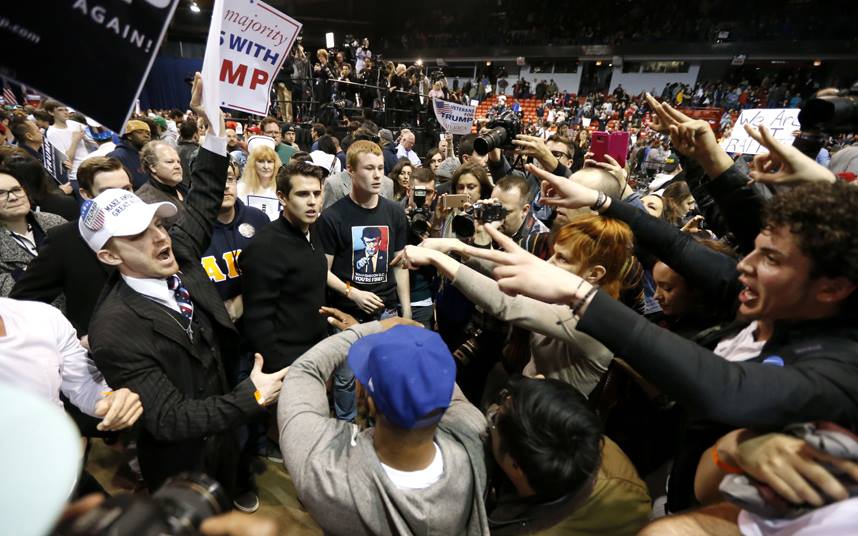On October 13th, in a packed auditorium in Columbus Ohio, the Trump campaign hosted its first and only rally dedicated to millennial voters. Students donning “Make America Great Again” caps cheered on as the candidate lamented Obama’s failure to mitigate student debt and the rising costs of education. While the crowd maintained a consistent cheer throughout his address, one moment evoked particularly boisterous applause: when Trump vowed to protect free speech on campus. Astonished by their reaction, Trump proclaimed, “Wow! You like that more than the lower costs!”
But we shouldn’t be surprised. The correlation between support for Trump on college campuses and the contemporary free speech movement cannot be overlooked; in fact, it stands as an integral reason for many millennials as to why they are supporting him.
While the debate over free speech has existed for decades, the past few years have seen its intensification on campus. With increasing frequency, students on the political-left have been requesting, or in some cases demanding, “trigger warnings” before professors raise sensitive topics. While content warnings can serve as critical tools for individuals who have experienced trauma, they can also act as a gag on expressing unpopular ideas. To this end, students have also created “safe spaces” where they can support one another in the absence of attitudes or views they find offensive, though the threshold for such offense is often low enough to constitute a minor disagreement in ideology. This has created a precarious position whereby the parameters of acceptable discourse are continuously changing, and truthfully, shrinking. As a result, students and faculty members alike are increasingly afraid to voice their opinions for fear of being ostracized by their peers. Even comedians have expressed reluctance to performing on college campuses for fear of backlash over politically incorrect jokes. The more conversations are shut down for not being “safe”, the more aggravated and silenced people feel.
Between the ‘safe-space touting’ left and the ‘free-speech propagating’ right, college campuses have devolved into places of perpetual culture war.
Within this context, the contemporary free-speech movement’s inception was that of a reactionary force, born to mock and troll those it deems oppositional to freedom of expression. This characterization, in recent times, most vividly describes the movement many have only recently come to know by name: the ‘alt-right’. With its focus on vulgar shock-humour, often sourcing tropes of Islamophobia, misogyny, anti-Semitism, among other hateful ideologies, the alt-right is devoid of legitimate political substance. Rather, as it pertains to free speech, its purpose is to enrage those who seek to suppress the espousal of even mainstream conservative ideas, such as gun ownership (mainstream in the US) and cutting government spending (even if in inefficient public sectors). Thus, between the ‘safe-space touting’ left and the ‘free-speech propagating’ right, college campuses have devolved into places of perpetual culture war.
But this war is grossly slanted in favour of one side. College conservatives often lament the double standards of campus administrators, maintaining that left-wing groups are given preferential treatment. One example of note: in February 2016, student protesters swarmed a California State University Los Angeles (CSULA) lecture hall, where conservative commentator Ben Shapiro delivered a speech about censorship on college campuses. Afterwards, the CSULA president organized a “healing space” where students met and recounted the “traumatization” and “brutalization” they endured as a result of the lecture. In response to the hubbub, the university’s president vowed to require that future political speakers share the stage with individuals who bestowed countering viewpoints. However, only a few weeks later, CSLUA hosted a video lecture by former Communist Party presidential candidate Angela Davis; no other speakers with differing viewpoints were present to contribute their ideas to the discussion.
It has become commonplace for conservative speakers to have their lectures disrupted by protesters, sometimes to the point of forced-cancellation. Such was the case at Brown University in 2013, where a lecture by Ray Kelly, the then New York City police commissioner was called off as a result of the increasingly disruptive protesters in the audience. A similar event happened at the University of California Irvine in 2010, where then Israeli Ambassador Michael Oren was set to deliver a speech on the topic of US-Israeli relations. Within minutes of starting the lecture, students began heckling the speaker, shouting insults such as “propagating murder is not an expression of free speech.” After the interruptions intensified, Oren left the podium, discontinuing the lecture. Whatever the intentions of these protesters, I wonder how much substantive change – economically, socially, culturally, politically – will be accomplished through shutting down the opinions of people they share society with.
With occurrences like these now routine, free-speech advocates have sought out alternative means to have their voices heard. Earlier this year, after “Trump 2016” was chalk-drawn on multiple locations throughout Emory University’s campus grounds, some students asserted they felt ‘triggered’ and ‘targeted’. Leftist groups mobilized in protest, storming the school’s administration building and demanding Emory’s president condemn the Republican nominee. In response, Republicans at Emory organized a free speech event, headlined by conservative activist and self-described “professional provocateur” Milo Yiannopoulos. While student protesters disrupted Yiannopoulos’ lecture, the significant number of students chanting Trump slogans dwarfed their demonstration.
Will all these ‘Trump chanting’ students be voting for the GOP nominee? Probably not. For many, Trump is not their conservative hero, but rather, a countercultural icon. Chanting his name means confronting the dominant voice on campus, the gatekeepers of political correctness who have been nothing but imperious to those who don’t subscribe to their dogma. Indeed, I even know a few liberals voting for Clinton that the allure of Trump’s anti-censorship has not been lost on.
Conservative students see Trump as their weapon in beating back the scourge of social justice that has consistently sought to silence their speech.
In the 2016 Presidential race, “political correctness” has become Trump’s all-purpose adversary, and with that an umbrella for many “called-out” collegians and silenced conservatives was created. The candidate has suggested that growing censorship by the left is the root-cause behind seemingly every threat confronting America, from illegal immigration, to the economy, to foreign policy, among others. Of course, it must be acknowledged that Trump himself is no advocate of free speech, especially as it pertains to the media: he is widely known for his tendency to threaten legal action against those reporters or outlets whose coverage of him he deems unflattering or troublesome. But this hasn’t dissuaded the average college Republican; conservative students see Trump as their weapon in beating back the scourge of social justice that has consistently sought to silence their speech. Although the proponents of free speech vary in political affiliation and motive, the birth of Trumpism has given many, his supporters and not, a perceived bulwark against “safe-spaces.”
With their lectures disrupted, their speakers chased off stage, and their clubs banned from campus, college conservatives have undoubtedly experienced mistreatment at the hands of their detractors. While Donald Trump, with his unconventional positions (at best), is far from the typical GOP nominee, he represents an antithesis to the social justice warrior; and for college Republicans, who are fed up with the status quo, that’s more than they could ask for.


